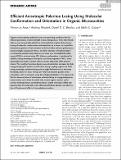Efficient anisotropic polariton lasing using molecular conformation and orientation in organic microcavities
Abstract
Organic exciton-photon polariton lasers are promising candidates for efficient generation of coherent light at room temperature. While their thresholds are now comparable with conventional organic photon lasers, tuning of molecular conformation and orientation as a means to control fundamental properties of their emission and further enhance performance remains largely unexplored. Here, we first report a two-fold reduction in the threshold of a microcavity polariton laser based on an active layer of poly(9,9-dioctylfluorene) (PFO) when 15% β-phase conformation is introduced. We then take advantage of the liquid crystalline properties of PFO and use a thin photoalignment layer to induce nematic alignment of the polymer chains. The resulting transition dipole moment orientation increases the Rabi energy, bringing the system into the ultra-strong coupling regime and facilitating anisotropic polariton lasing with an eight-fold reduction in absorbed threshold, down to 1.14 pJ/0.36 μJcm-2 for the direction parallel to the orientation, with no emission along the orthogonal direction. This represents the first demonstration of anisotropic polariton lasing in conjugated polymer microcavities and a lower threshold than current organic vertical cavity surface-emitting photon and polariton lasers. Dipole orientation offers new opportunities for switchable, more efficient polaritonic devices and observation of fundamental effects at low polariton numbers.
Citation
Le Roux , F , Mischok , A , Bradley , D D C & Gather , M C 2022 , ' Efficient anisotropic polariton lasing using molecular conformation and orientation in organic microcavities ' , Advanced Functional Materials , vol. Early View , 202209241 . https://doi.org/10.1002/adfm.202209241
Publication
Advanced Functional Materials
Status
Peer reviewed
ISSN
1616-301XType
Journal article
Description
F.L.R acknowledges funding from the Alexander von Humboldt Foundation through a Humboldt Fellowship. A.M. acknowledges funding from the European Union Horizon 2020 research and innovation programme under the Marie Skłodowska-Curie grant agreement No. 101023743 (PolDev). D.D.C.B. thanks the Sumitomo Chemical Company and DIC Corporation for provision of PFO and SD1, respectively. D.D.C.B. further acknowledges support from King Abdullah University of Science and Technology, Jiangsu Industrial Technology Research Institute (JITRI) and JITRI-Oxford IMPACT Institute (R57149/CN001). This research was financially supported by the Alexander von Humboldt Foundation (Humboldt Professorship to M.C.G.) and by the European Research Council under the European Union Horizon 2020 Framework Programme (FP/2014-2020)/ERC Grant Agreement No. 640012 (ABLASE).Collections
Items in the St Andrews Research Repository are protected by copyright, with all rights reserved, unless otherwise indicated.

